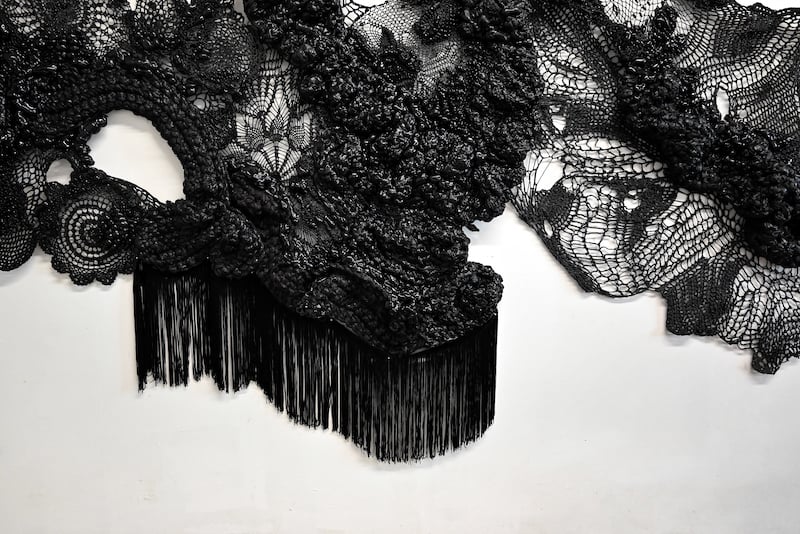This month, the Atlanta art world seems to be reflecting the truth of the cliché that nothing is ever as simple as it looks.
We could start with T. W. Pilar’s Hyperobjects, an elegantly designed show open through December 2 at a relatively new little gallery, Memento.
Pilar’s show is all over the place yet unified on both visible and conceptual levels. Beginning with a wall of moss in the staircase leading down to the main gallery, it continues with seductively light-reflecting, steel-framed panels made from quilted/melted black plastic garbage bags.

A potted plant by the window seems anomalous but is an experiment in seeing how a living plant responds to plastic-polluted potting soil. The whole aesthetic/conceptual ensemble is tied together by a sense of interior design that is its own form of hyperobject.
It is total coincidence that plastic, plus a gloss or matte black palette, also plays a central role in the more complex and consciously ragged aesthetic of Hannah Ehrlich’s Decomposition, at Sandler Hudson Gallery through December 2. As metaphors for the tangles of human emotions, Ehrlich’s textiles are a different kind of hyperobject, subjective rather than object-focused. But her expressions of it are exquisitely beautiful and enthralling physical objects, well-known among lovers of textiles for their surface textures as well as their stylistic depths.
The works in this show incorporate a mix of techniques not ordinarily found together, with an equal mélange of natural and artificial materials. The tour de force, Never alone: accompanied by grief, combines various fibers with beads, artificial plants and spray insulation.
It’s just short of spine-tingling proof of the Hegelian idea of a zeitgeist that the one free-standing object in Ehrlich’s show is an artificial potted plant made from silk and plastic, painted black. It’s titled In the process of decaying: tree found in dentist office edition and is a stunningly unnerving object, rightly occupying a mid-gallery location.

Fernbank Museum of Natural History is offering an unusual mash-up of natural and historical networks. The annual Winter Wonderland: Celebrations and Traditions Around the World show of internationally focused Christmas trees (and also culturally appropriate nontree displays), for example, offers a look at winter holiday traditions sometimes far removed from the cultural origins of the decorated tree that serves as the main shared motif. Each year, it’s a fun immersion in the world’s interconnected ways of celebration.
Winter Wonderland runs through January 7 and is completely different from Fernbank’s main exhibition Vikings: Warriors of the Sea. This is a family-oriented survey (through January 1) of a frequently misunderstood culture most famous for its seaborne raiding expeditions, but one that also engaged in far-flung settlements that were part of ambitious trade networks that spanned oceans.
The full-scale mock-up of a Viking ship and the hands-on swords and chain mail will interest more people than the trade networks or the details of Viking daily life and religion, but the maps and the context-setting placards are there to be studied, along with actual archaeological objects.

If it’s pure interconnection you’re after, there is Fernbank’s AGLOW. On select evenings through February 25 AGLOW’s combination of a light show (with educational components) in the WildWoods forest behind the museum building and the Björk–Merlin Sheldrake movie Fungi: Web of Life in the Giant Screen Theater is clearly the top attraction. Who realized there was so much more to know about not just mushrooms but the underground life of trees? Sheldrake has written Entangled Life, a bestselling book on the topic of fungi, and Björk has become an enthusiastic collaborator in spreading the news.
Talking of fungi, the world very nearly missed out on the story of Peter Rabbit. If his creator Beatrix Potter’s scholarly paper on mushrooms had gotten its proper due, she would have pursued science as a full-time profession. Her meticulous watercolors of mushroom species and evocative images of gardenscapes co-exist with her nature-informed children’s book illustrations in Beatrix Potter: Drawn to Nature at the High Museum of Art through January 7. (The Alliance Theatre is presenting a companion piece, the musical Into the Burrow, through December 23.)
::
Dr. Jerry Cullum’s reviews and essays have appeared in Art Papers magazine, Raw Vision, Art in America, ARTnews, International Review of African American Art and many other popular and scholarly journals. In 2020, he was awarded the Rabkin Prize for his outstanding contribution to arts journalism.

